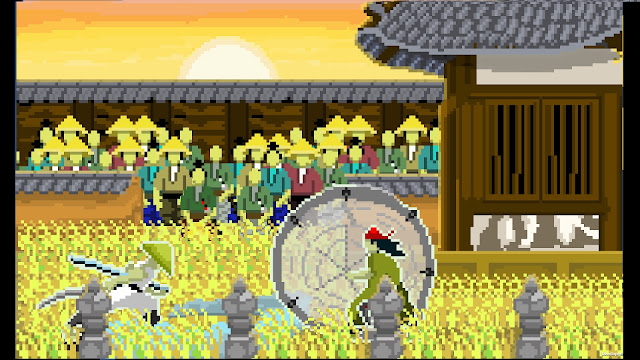Review by Matt S.
I really like the idea of a one hit kill fighting game, and certainly Slice, Dice & Rice is one of my favourite fighting games of recent times. The intensity knowing that a single hit will be enough to kill your character has led me to some very tense, exciting, and highly skill-based matches. It’s a simplified fighting game, in that there aren’t combos or special attacks to remember, but it somehow manages to be more thrilling, because you know that a single mistake, or a cleverly executed feint, is all that stands between you, and either victory or loss.
It was always going to be inevitable that other developers would crib ideas from Slice, Dice & Rice. One Strike came out on PC around six months after Slice, Dice & Rice, and that can’t be coincidence, especially given that its foundations are exactly the same. The difference is that while Slice, Dice & Rice is a satirical take on the Mortal Kombat-style aesthetic, One Strike ops for a pixel “retro” visual style. It’s the only option on Nintendo Switch for people that want this kind of action, but sadly, it’s just not that good.
One Strike’s action is nowhere near as fast and fluid as its immediate rival, for a start, instead opting for a stiffness that encourages players to keep their defences right up, and then try and find ways to goad their opponent into an attack. Then it’s just a matter of deflecting the attack and countering to victory. Lacking the elaborate dance that Slice, Dice & Rice offered players means that One Strike feels more limited right out of the gate, and regardless of which character you choose, you’re effectively forced to approach combat in the same way.
Perhaps the best way to look at this kind of fighting game is through the same lens that we look at the sport of fencing in the real world. Visually, fencing is a sport that involves a lot of careful probing before an explosive bit of activity that ends, seconds later, with one athlete or the other having connected for a point. One Strike superficially resembles this structure, but the lack of fluidity in character movement also means that the probing side of the sport just isn’t much fun. Better to belt right into your opponent from the outset and just hope for the best.
The lack of depth is felt in the gameplay modes, too. You’ve got One Life (where you need to clear a series of battles in which a single hit means game over), Arcade (much the same thing, but broken into rounds, just like a standard fighting game, rather than a single hit kill), Tournament (functionally no different to One Life), and team (where you need to defeat three different characters in a row to win). There’s also local multiplayer, but no online play. There are only six characters to choose between, which is much the same in Slice, Dice & Rice, but at least that game had an amusing story mode to go with the limited character range.
I believe there are more characters on the way, and that’ll help One Strike, because one thing the game does really well is make sure that each character feels substantially different to fight with. Some are more technical characters because either they need to deal with limited range, or are cumbersome to block with, so if the developer is able to add meaningful variety to the character roster, then One Strike has some hope yet to be a fun multiplayer game in the same way that something like Nidhogg is; limited, but easy and fun to play in short bursts with a friend.
One Strike’s other great failing in comparison to Slice, Dice & Rice is the presentation. I know that retro pixels are a popular aesthetic for developers because players tend to enjoy the nostalgia that it provides, but I also feel that in a lot of cases the pixels are used as an excuse for a lack of ability around animation and detail. One Strike’s characters are chunky in size, but completely lack for personality or interesting design, and environments are only competent. This is an example of a game that uses pixel art for convenience rather than any particular aesthetic impact, and as a consequence it looks cheap on the eyes. The game also lacks the rhythmical thudding of the music in Slice, Dice & Rice, which really helped to reinforce the dance-like quality of the movement in that game. Here it sounds like a royalty-free collection of MIDI tracks.
One Strike is mildly fun, but woefully ill equipped to provide any long term value. With no online play, it’s never going to develop a community of players that care to master it, and there are so many other great choices for local multiplayer on the Nintendo Switch. Look at Overcooked, or Mario Kart. If you want a fighting game, then grab the Street Fighter collection, or BlazBlue Cross Tag Battle. I appreciate that One Strike is about as cheap as games come on Switch, but there’s a reason for that; it’s also going to last you five minutes until the mild first impressions are replaced by an overwhelming sense of dullness.
– Matt S.
Editor-in-Chief
Find me on Twitter: @digitallydownld
 |
| Please Support Me On Patreon!
|










